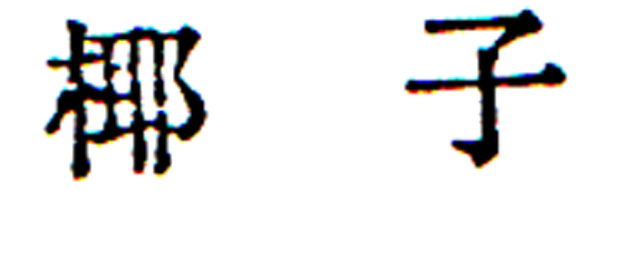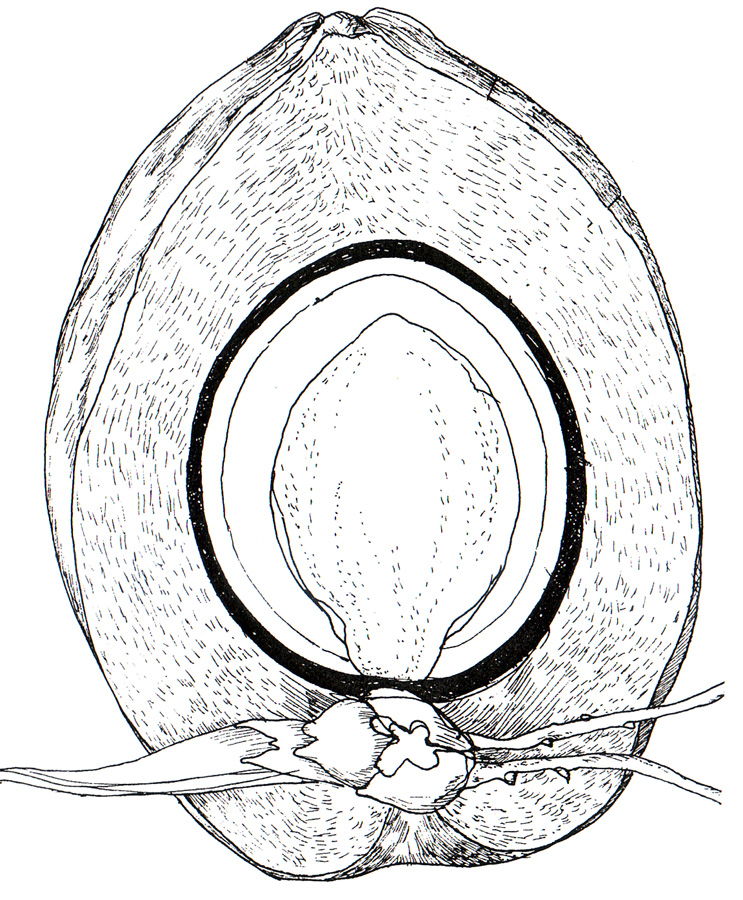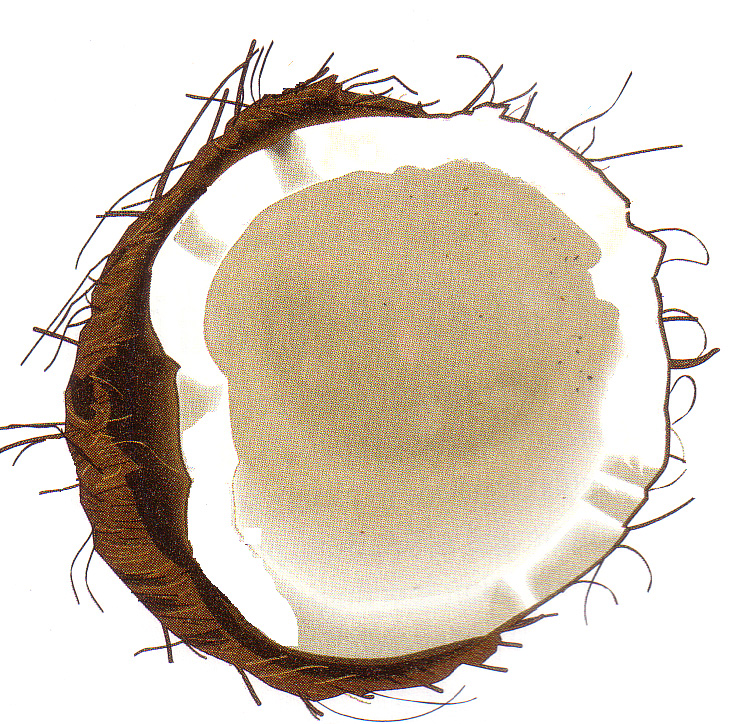
| What is Flavor and Fortune? |
| How do I subscribe? |
| How do I get past issues? |
| How do I advertise? |
| How do I contact the editor? |
Read 12978677 times
Connect me to:
| Home |
| Articles |
| Book reviews |
| Letters to the Editor |
| Newmans News and Notes |
| Recipes |
| Restaurant reviews |
| Article Index (all years, slow) |
| List of Article Years |
| Article Index (2025) |
| Article Index (last 2 years) |
| Things others say |
| Related Links |
| Log In... |
| Authors |
| Categories & Topics |
Coconut
| by Jacqueline M. Newman |
Nuts and Chestnuts
Winter Volume: 2009 Issue: 16(4) page(s): 27, 28, and 29

 In China and worldwide, the most important parts of Coco nucifera are its flesh when ripe, and coconut oil pressed from it. These are inside the husk and hard shell, the latter somewhat like a hairy bowling-ball. This fruit/nut is the seed of one in the Palmae or palm-family of trees. While commonly called 'coconut,' few know how heavy one can be. Some coconuts grow a eighteen inches in length and weigh up to three pounds in heft. Most also do not know this is the most extensively grown and used seed in the world, and that it is the world's most important palm.
In China and worldwide, the most important parts of Coco nucifera are its flesh when ripe, and coconut oil pressed from it. These are inside the husk and hard shell, the latter somewhat like a hairy bowling-ball. This fruit/nut is the seed of one in the Palmae or palm-family of trees. While commonly called 'coconut,' few know how heavy one can be. Some coconuts grow a eighteen inches in length and weigh up to three pounds in heft. Most also do not know this is the most extensively grown and used seed in the world, and that it is the world's most important palm.
When mature and dry, this large egg-shaped-husk actually has many names, as do other parts of the plant. The flesh is also called its meat, the Chinese call it ye zi, ye li, ye yi, or ye tzu. It is slightly sweet, fragrant, and firm when ripe, and thought originally to be from the Malay Archipelago, the South Pacific, or perhaps even tropical America. Others believe humans may have spread the coconut across the Pacific, or that it got there itself because coconuts float and bob on water. People can carry them long distances or they can get where they end up staying fresh for long periods of time.
In China, these Palmae were referred to as early as the second century BCE. Six centuries later, Chi Han clearly describes both the fruit and the tree as a tall plant, often branchless, with fruits the size of a round watermelon. This tree starts fruiting at six to ten years of age and should you want to grow one, you must plant the entire husk for germination.
 When fifteen to twenty years of age, this so-called drupe or stone-fruit-tree reaches full production, and is usually eighty to one hundred feet tall. There are newer dwarf varieties. Either produce fifty to two hundred fruits each year throughout the year; and it takes a year from seed to full size. They mature throughout the year until a tree is some eighty years old, or thereabouts. To get coconuts down from the tree, many climb the trunk and use a flat-bladed knife to cut them down. Others wait for them to fall and then collect them.
When fifteen to twenty years of age, this so-called drupe or stone-fruit-tree reaches full production, and is usually eighty to one hundred feet tall. There are newer dwarf varieties. Either produce fifty to two hundred fruits each year throughout the year; and it takes a year from seed to full size. They mature throughout the year until a tree is some eighty years old, or thereabouts. To get coconuts down from the tree, many climb the trunk and use a flat-bladed knife to cut them down. Others wait for them to fall and then collect them.
When young, the coconut's fruit is watery, there is lots of it, and as it matures and ripens, its jelly-like flesh gets more firm, grows and hardens to about half-inch in thickness and much of that liquid gets absorbed into the flesh as it matures. Some drink this watery liquid when this fruit is immature, but that is not its main use; nor does everyone really like it.
Worldwide, this most used seed is commercially planted in tropical lowlands, and is widespread in southern China. There, traditional medicinal practitioners believe it neither warm nor cold, and they say it enlivens saliva, benefits urine, and repels insects. Furthermore, they recommend the water in it for heat stroke and for fever with thirst. They also suggest its consumption for diabetics, and that they take it twice daily.
These practitioners report the flavor of the shell bitter, astringent, and of warm nature; and that it can relieve itching. They also recommend a cup of this coconut water with a little sugar and salt to those suffering from diarrhea, to take it three times a day for three days, then only one cup a day thereafter.
For those with constipation, the flesh of half of a coconut should be had morning and evening. As to the shell, that is used crushed and as a poultice for chronic foot ulcers, particularly for the elderly. Candied, the flesh is used for senility, that is until improvement is seen.
Actually, coconut is really not a nut, but a seed inside a husk. It is best purchased when heavy and with only a small amount of water within. Shake it to hear and feel how much. To open it, most stores sell it husk removed, and the buyer needs a pick or screw driver to punch through two if its three soft depressions, called eyes. After that is done, one can drain the coconut water. Most discard this; others use it medicinally or in soups or stews.
TO CRACK THE BROWN SHELL put the whole coconut in a 350 degree Fahrenheit oven for about fifteen or twenty minutes, then use a hammer, bang on the shell, and it will break open or crack. Next, cut out the meat, called flesh, with a blunt knife. That is the part eaten or candied or dried and grated. It is also used to make coconut cream or coconut milk. Once the meat or flesh has been removed, it does spoil quickly. Keep it in the refrigerator for a day or two or freeze it. It is ready to use shortly after removing it from the freezer.
TO MAKE COCONUT MILK OR COCONUT CREAM grind the flesh with water. Some use cold, others warm, and still others use hot water. Almost all do so for some two minutes. Then, best left to sit about fifteen minutes. Next strain it through several layers of cheesecloth squeezing out all possible liquid. This first press is usually called coconut cream. Do that a second time, and it is most often called coconut milk. Either of these can be used immediately or they can be refrigerated for three or four days.
Besides the cream, milk, water, and the flesh, coconuts have other uses in China and in the rest of the world. The flesh, cream, milk, and sometimes the water are components of soaps, margarine, vegetable shortening, detergents, and shampoos. Coconut oil is extracted from the flesh when dried; at that point it is called copra. Solid at temperatures below seventy-four degrees Fahrenheit, this oil is loaded with saturated fat, and though good for frying as it does not burn until it reaches about 480 degrees Fahrenheit, it is difficult to digest.
The husk is used to make a fiber called 'coir' which is soaked in salt water until soft enough to weave or twist into rope or coconut matting. As such its end products are very durable. Coir can also be burned for fuel; and the dust from the husk can be used for or added to fertilizer, insulating board, and other products.
Coconut tree trunks are used for building material and are used as wood. The leaves are used for and in roof thatching, the flowers used for food, and the water, milk, or cream fermented and used as alcoholic beverages.
Coconut oil is not one of the top oil seeds in China nor in the rest of the world. The ones that are: rape, peanut, sunflower, and sesame oils, and after them, soybean, flax, hemp seed, Perilla, cotton, and castor seeds. These oils became available when techniques for pressing were developed. Coconut oil is not an easy one to extract form its seeds; others are easier.
Fermented coconut juice is to the Chinese, not new. It was written about in The Old History of the Thang Dynasty, in an item called Chiu Thang Shu. Nor is use of the flesh; that needed simple drying, crushing, steaming, and/or cooking techniques., and so its use is quite old.
Once when in the Xian region, I was given a dual-use press, it could make noodles and be used with an insert to make coconut oil. Intended to use over a three-foot diameter wok for the former, and an extraction/distillation device for the latter, must confess that other than burdening my luggage with some ten to twelve pounds, it has never been used.
In Asian markets, there are many ways to buy coconut beyond in the husk or shell. It is made into cream or milk and sold in cans or pasturized in cartons. The flesh nowadays is given a freeze-dry treatment to be reconstituted before use. The flesh is also toasted until brown and sold in plastic bags, mostly for sweets or to thicken or enrich some dishes. Rarely does one see the leaves, other than dry, and these are used to wrap then cook some foods. The sprouted seeds are eaten like candy, some like celery.
In Hainan Island, they say that the coconut tree has sixty or more uses, some already mentioned. Ones not mentioned are using the shell for bowls and serving utensils, and for ornaments and jewelry. The flesh or coconut strips are cut in small pieces and boiled in sugar syrup; these are popular around the New Year. Of course, the coconut meat or flesh is used in Imperial and everyday dishes. The Emperors liked dishes served in them, one famous one made is Chicken with Mushrooms in Whole Coconut. More popular are spare ribs flavored with coconut. Fried rice likewise, and coconut pudding served in or out of coconut shells are found at most dim sum emporia. They also liked eating from those decorated for them.
| Fish Soup with Greens and Coconut |
|---|
1/4 pound fillet of tile fish, cut into one-inch squares 2 teaspoons thin soy sauce 2 teaspoons cornstarch 1 teaspoon sesame oil 2 teaspoons Chinese rice wine 1/4 teaspoon ground white pepper 5 cups chicken broth 2 teaspoons shredded coconut 1 teaspoon minced chopped fresh cilantro Preparation: 1. Mix fish squares with soy sauce and cornstarch and let rest ten minutes. 2. Put fish mixture, sesame oil, rice wine, ground white pepper, and the chicken broth into a pot and heat on medium heat until very hot. 3. Put into soup tureen or individual soup bowls, Sprinkle coconut and minced cilantro on top and serve. |
| Chicken with Coconut |
|---|
1 whole chicken breast 2 Tablespoons corn oil 1 Tablespoon Chinese rice wine 2 Tablespoons cornstarch 1/2 cup coconut cream 2 Tablespoons curry powder 1 teaspoon sa cha sauce 2 potatoes, peeled and cut into two-inch cubes 1 small onion, peeled and cubed 2 scallions, cut into one-inch pieces Preparation: 1. Cut chicken into two-inch pieces. Heat wok or fry pan, add the oil, and stir-fry then chicken pieces until browned. 2. Mix rice wine, corn starch, the coconut cream, and the curry powder, and the sa cha sauce. Stir this mixture into the chicken along with two cups of boiling water. Bring to the boil and quickly lower the heat to a simmer, add the potatoes and the onion pieces and simmer for thirty minutes. Add the scallions and serve. |
| Beef, Sweet Potatoes, and Coconut |
|---|
2 Tablespoons corn oil 4 cloves garlic, peeled and minced 1 onion, peeled and cubed 1/2 pound flank steak, thinly sliced 1 Tablespoon cornstarch 3 Tablespoons curry powder or curry paste 1 cup coconut milk 1 large sweet potato, peeled and cut into two-inch cubes 1/2 cup shredded coconut 2 Tablespoons sliced almonds 1/4 cup fresh coriander leaves Preparation: 1. Heat wok or fry pan, add the oil and the garlic, and stir-fry for half minute, then add the onion and continue to stir-fry for two more minutes. 2. Mix beef with cornstarch and the curry powder or paste, and stir fry just until the meat is no longer pink. 3. Add the coconut milk and the sweet potato and one cup of boiling water, then simmer for half an hour. Remove from the heat, put into a serving bowl, sprinkle the coconut, almonds, and the coriander on top, and serve. |
| Coconut Spareribs |
|---|
1 pound spare ribs, cut into one-inch pieces and then separated 2 Tablespoons cornstarch 2 Tablespoons corn or another vegetable oil 4 slices ginger, peeled and diced 3 Tablespoons mushroom soy sauce 1 Tablespoon Chinese black vinegar 1 Tablespoon crushed Chinese brown sugar 2 Tablespoons sweet potato flour 1 scallion, cut into one-half-inch pieces Preparation: 1. Toss the spare rib pieces with the cornstarch. 2. Heat a wok or fry pan, add the oil, then the ginger and toss for one minute, before adding the spare ribs. Stir-fry them for five minutes. 3, Add the soy sauce, vinegar, and the brown sugar, and stir-fry another four minutes. 4. Add the potato flour by sprinkling it in slowly, stirring continuously, and continue to stir-fry it for two minutes. Then put it on a platter, sprinkle the scallion pieces on top, and serve. |
| Hainan Fried Rice |
|---|
1 can green or soft coconut, drained 1 boneless chicken thigh, diced 1/4 teaspoon salt and pepper 2 Tablespoons corn or vegetable oil 1 Tablespoon chili paste or sa cha sauce 2 cups hot cooked rice 1 Tablespoon chopped peanuts 1 Tablespoon fried shallots Preparation: 1. Cut coconut pieces into thick slices. 2. Mix chicken with the salt and pepper. 3. Heat wok or fry pan, add the oil, and the chicken. Stir-fry for one minute, then ass the chili paste or the sa cha sauce, and mix well, then add the hot rice and slowly stir until it is mixed well. Put into a serving bowl, add the peanuts and shallots, toss once, then serve. |
| Coconut Custard, Chinese Style |
|---|
1/2 cup granulated sugar 3 Tablespoons gelatin powder 1 can coconut juice or drink (ten to eleven ounces) 1 egg white, beaten just until it foams 1 Tablespoon shredded coconut 8 goji berries Preparation: 1. In a small pot, mix sugar and gelatin powder with one and a half cups cool water, stir, and let set for ten minutes. Then bring this to the boil, add the coconut juice or drink, and the egg white foam, and two ice cubes. Stir until well mixed and pour into a rectangular or square container, cover with plastic wrap, and refrigerate until firm. 2. Cut into eight diamond shape cubes, put a goji berry on each, and serve. |

Copyright © 1994-2025 by ISACC, all rights reserved
Address
3 Jefferson Ferry Drive
S. Setauket NY 11720